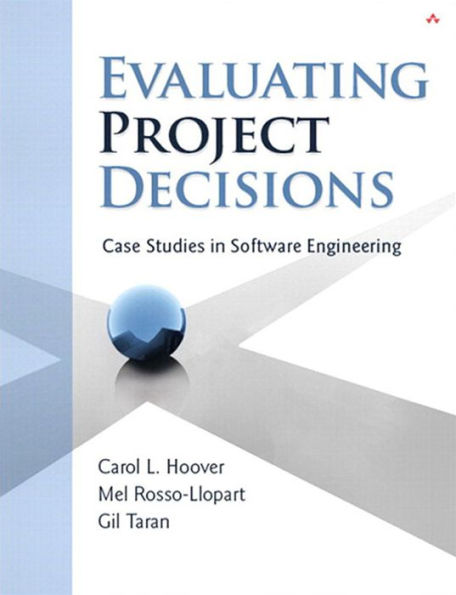
Evaluating Project Decisions: Case Studies in Software Engineering
400
Evaluating Project Decisions: Case Studies in Software Engineering
400eBook
Related collections and offers
Overview
Effective decisions are crucial to the success of any software project, but to make better decisions you need a better decision-making process. In Evaluating Project Decisions, leading project management experts introduce an innovative decision model that helps you tailor your decision-making process to systematically evaluate all of your decisions and avoid the bad choices that lead to project failure.
Using a real-world, case study approach, the authors show how to evaluate software project problems and situations more effectively, thoughtfully assess your alternatives, and improve the decisions you make. Drawing on their own extensive research and experience, the authors bridge software engineering theory and practice, offering guidance that is both well-grounded and actionable. They present dozens of detailed examples from both successful and unsuccessful projects, illustrating what to do and what not to do.
Evaluating Project Decisions will help you to analyze your options and ultimately make better decisions at every stage in your project, including:
- Requirements–Elicitation, description, verification, validation, negotiation, contracting, and management over the software life cycle
- Estimates–Conceptual solution design, decomposition, resource and overhead allocation, estimate construction, and change management
- Planning–Defining objectives, policies, and scope; planning tasks, milestones, schedules, budgets, staff and other resources; and managing projects against plans
- Product–Proper product definition, development process management, QA, configuration management, delivery, installation, training, and field service
- Process–Defining, selecting, understanding, teaching, and measuring processes; evaluating process performance; and process improvement or optimization
In addition, you will see how to evaluate decisions related to risk, people, stakeholder expectations, and global development. Simply put, you’ll use what you learn here on every project, in any industry, whatever your goals, and for projects of any duration, size, or type.

Product Details
| ISBN-13: | 9780321685636 |
|---|---|
| Publisher: | Pearson Education |
| Publication date: | 10/27/2009 |
| Sold by: | Barnes & Noble |
| Format: | eBook |
| Pages: | 400 |
| File size: | 6 MB |
About the Author
Dr. Carol L. Hoover is president and chief executive officer of BiznessLegion, LLC, a consulting company that is currently developing innovative strategies and technology to help organizations manage the software change lifecycle. Mel Rosso-Llopart and Gil Taran are associate teaching professors for the School of Computer Science at Carnegie Mellon University. There, Rosso-Llopart is the associate director of the Master of Software Engineering program and the director for distance education development in the Information Networking Institute. Taran holds the position of chief executive officer for iCarnegie, Inc., an educational affiliate of Carnegie Mellon providing modern academic curricula and professional certifications all over the world.
Table of Contents
Preface xi
Acknowledgments xxi
About the Authors xxiii
Chapter 1: Managing Decisions 1
1.1 Chapter Objectives 1
1.2 Context 1
1.3 Decision Model for Software Engineering 5
Case Study: Software Test Rerun Problem 7
Case Study: California Bridge Problem 10
Case Study: Unfamiliar Legacy Code Problem 12
Case Study: Data-Processing Problem 14
1.4 Summary 18
Chapter 2: Managing Requirements 19
2.1 Chapter Objectives 19
2.2 Context 19
2.3 Case Studies 39
Case Study: The New Account Project at HBC 39
Case Study: On Time, Within Budget, but Wrong 54
2.4 Summary 65
Chapter 3: Managing Estimates 67
3.1 Chapter Objectives 67
3.2 Context 67
3.3 Case Studies 77
Case Study: Estimation as a Tool 78
Case Study: When a Team Runs a Race 84
3.4 Summary 92
Chapter 4: Managing Plans 93
4.1 Chapter Objectives 93
4.2 Context 93
4.3 Case Studies 108
Case Study: To Replan or Not to Replan? 109
Case Study: Managing Plans Is in the Details 125
4.4 Summary 137
Chapter 5: Managing Product 139
5.1 Chapter Objectives 139
5.2 Context 139
5.3 Case Studies 146
Case Study: New Technology–Is It Always the Best? 147
Case Study: Why Is This Product Wrong? 159
5.4 Summary 165
Chapter 6: Managing Process 167
6.1 Chapter Objectives 167
6.2 Context 167
6.3 Case Studies 174
Case Study: Bank on the Verge 175
Case Study: Damn the Process, Full Speed Ahead 189
6.4 Summary 193
Chapter 7: Managing Risk 195
7.1 Chapter Objectives 195
7.2 Context 195
7.3 Case Studies 201
Case Study: SEWeb and Russoft Technologies 201
Case Study: Falcon Edutainment and the RiskSim Project 223
7.4 Summary 231
Chapter 8: Managing People Interactions 233
8.1 Chapter Objectives 233
8.2 Context 233
8.3 Case Studies 242
Case Study: To Be or Not to Be: A Sense of Urgency at TestBridge 243
Case Study: A Friend or Foe at Hanover-Tech 258
8.4 Summary 264
Chapter 9: Managing Stakeholder Expectations 267
9.1 Chapter Objectives 267
9.2 Context 267
9.3 Case Studies 275
Case Study: TCP Enhancements at Gigaplex Systems 275
Case Study: Tough Sell at Henkel Labs 292
9.3 Summary 304
Chapter 10: Managing Global Development 305
10.1 Chapter Objectives 305
10.2 Context 305
10.3 Case Studies 311
Case Study: Globally Distributed Team: FibreNet Project
Case Study: Managing Global Software Development at FibOptia 330
10.4 Summary 341
References 343
Index 355
